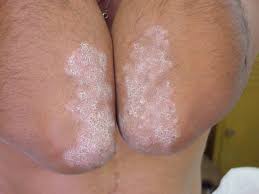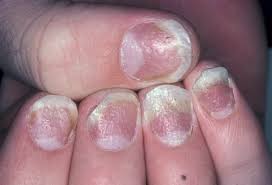Connect With Us
Psoriasis
What is Psoriasis?
Psoriasis is a skin condition caused by faster-than-normal turnover of skin cells. Normally, new skin cells rise to the surface of the skin once a month; the old surface skin cells die and slough off while the new cells are moving to the surface. In people who have psoriasis, the new cells move to the surface so rapidly that the dead cells build up on the surface in dry, whitish-silver patches. These ‘silver scales” are characteristic of psoriasis.
Psoriasis may come and go without warning. It usually appears on areas that are subject to friction (i.e. elbows, knees, scalp). Its onset can be triggered by numerous things. Some triggers include:
- Alcohol consumption
- HIV infection
- Streptococcal pharyngitis
- Certain medications
- Emotional stress (especially in children)
What Causes Psoriasis?
The precise initiating event causing psoriasis remains unclear. Psoriasis is an autoimmune disease and seems to run in families. Psoriasis tends to be more severe in people with weakened immune systems, including those with AIDS and those undergoing treatment for cancer. Stress also seems to make psoriasis worse. There are two peak ages for the development of psoriasis. The first is early adulthood and the second is during the 6th decade of life. Sometimes psoriasis develops during childhood. These patients often have a more sever form associated with psoriatic arthritis and nail involvement.
What are the Symptoms of Psoriasis?
People with psoriasis typically have areas of thick, reddened skin with dry, whitish-silver patches. The dry patches are called psoriatic plaques. The skin may feel itchy.
Psoriasis is most commonly found on the elbows, knees, and bottoms of the feet. It can also affect the fingernails, toenails, and joints of the body. On the nails, psoriasis can appear as pitting of the nail or nails may have an “oil spot” appearance. Psoriasis of the nail may also mimic the appearance of nail fungus.



Home Care
Keep the skin well-moisturized to maintain skin health and ease the discomfort of psoriasis. Oatmeal baths can soothe the skin. Hypoallergenic moisturizer, applied on a regular basis, also helps.
Phototherapy, or light therapy—which involves exposing the skin to UV-B light—may be helpful as well. Some people use UV-B lights at home under a doctor's direction. Other patients carefully time their exposure to sunlight. Talk to your doctor to see if phototherapy may be helpful for you.
If you have psoriasis on your feet, see a podiatrist. A podiatrist can also help determine the cause of reddened, itchy feet. (Psoriasis can mimic severe athlete's foot or contact dermatitis.) If you have red, irritated feet that haven't responded to home or medical treatment, see a Foot and Ankle Specialist.
How is Psoriasis Diagnosed and Treated?
A podiatrist will carefully examine your feet and take a thorough medical history. He or she may also take a tiny sample (biopsy) of the affected area to diagnose psoriasis. This is the technique of choice for confirmation of psoriasis.
Treatment depends on the severity of the disease. Mild cases of psoriasis can be treated with topical steroid creams, applied directly to the area. More severe cases of psoriasis may need systemic (whole body) treatment. Drugs that depress the immune system, including methotrexate and cyclosporine, help some people with psoriasis. Certain biologic drugs, including Humera® and Enbrel®, are also useful for psoriasis. If you have severe psoriasis, you may work with a variety of medical specialists to get your psoriasis under control.
Can Psoriasis be Prevented?
You can't prevent the development of psoriasis, but you can avoid things that make your psoriasis worse. Stress management techniques may help some people with psoriasis. Alcohol, dry air, and too much or too little sunlight seems to trigger psoriasis for some people, so controlling your exposure to things that irritate your psoriasis may help. Talk to your doctor to find out what you can do to control your psoriasis at home.
